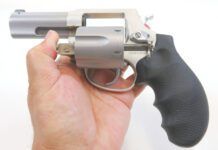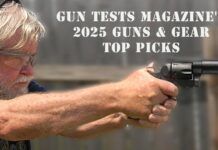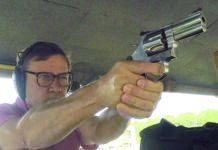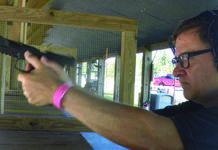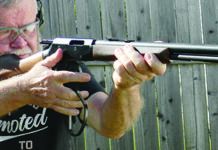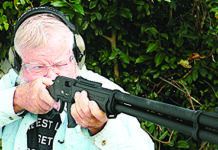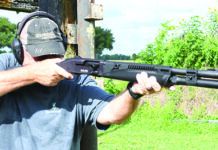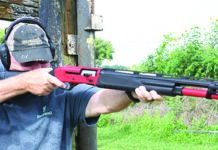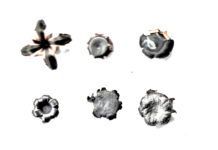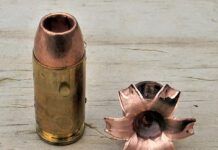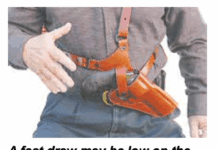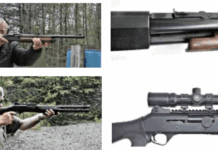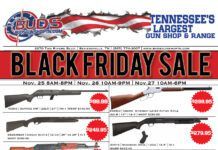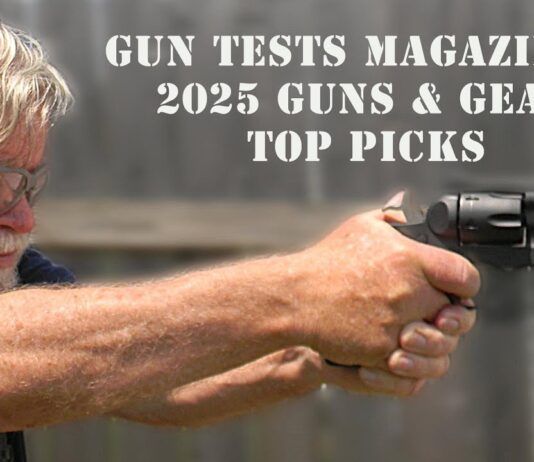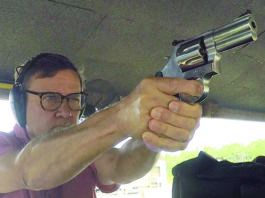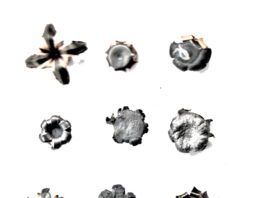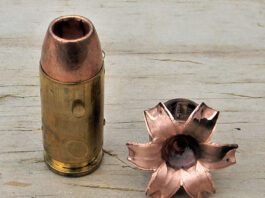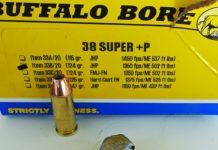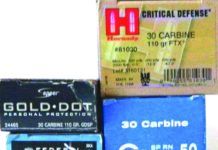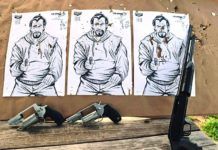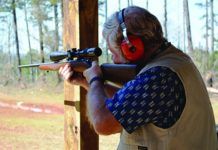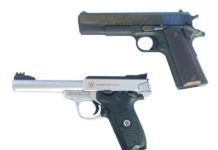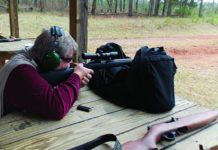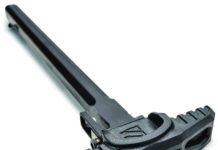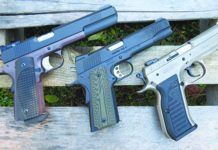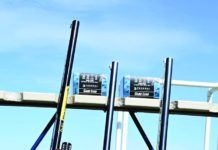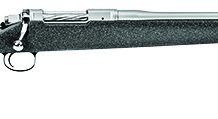38 Super Loads: We Like Buffalo Bores Jacketed HPs
The 38 Automatic Colt Pistol Super cartridge isn't our most popular handgun cartridge, but in the loyalty of a small following it is unique. The 38 ACP Super must be understood as to its potential. All modern loads are marked 38 ACP Super +P, but all loads are in the same pressure range of safety demanded by the SAAMI, despite very different performance. Many are loaded below the potential of the cartridge. The 38 ACP, introduced in 1900, is no longer in regular production. This is because the original 38 ACP, introduced in 1899, was later upgraded to the powerful 38 ACP Super. Though the cartridge-case dimensions are identical, the Super is the much hotter cartridge. Modern SAAMI standards called for the 38 Super to be labeled 38 ACP Super +P, which is confusing. While some of the modern loads are hotter than others, all are safe for a 38 ACP Super handgun in good condition. The old double-link Colt 38 ACP self loaders should never be fired with Super loads. The 38 Super was once a handloading proposition for maximum performance. Using 9mm JHP bullets and sometimes heavy hard-cast 38 Special lead bullets, handloaders upgraded the 38 Super. The 115-grain JHP was jolted to 1400 fps or beyond. Today Cor-Bon, Buffalo Bore, and Double Tap offer high-performance loads rivaling some of the hotter handloads of yore. The 38 Super may be enjoying an upsurge in popularity as both Federal Cartridge Company and SIG Sauer have introduced new JHP loads for it. We were able to find 12 personal-defense loads and four FMJ loads. For all the testing, we fired the rounds out of a Rock Island Armory 1911, a reliable and affordable 38 Super launchpad. It's a standard Government Model steel-frame pistol with 5-inch barrel.
First, we tested the full-metal-jacket loads for use in competition and general shooting. We recorded basic accuracy, velocity, and energy for these rounds, but as you'll see in the accompanying table, their widths, weights, and penetration readings are all the same. The FMJs didn't expand, didn't shed weight, and shot through our water-jug lineup, putting them at +24 inches, penetration beyond what we recommend for self-defense.
The Fiocchi 129-grain FMJ proved to be the most accurate by a margin, with a clean burn and excellent overall performance. It is the Best Buy for accuracy and economy. The SIG Sauer 125-grain FMJ loading was close behind the Fiocchi loading, with little real difference other than price. While the Prvi Partizan 130-grain FMJ was less expensive, it did not burn as cleanly nor was it as accurate. The Winchester 130-grain FMJ was the most expensive, and it was middle of the pack in terms of performance. Accordingly, we'd rate the Fiocchi as an A, the SIG an A-, the Prvi Partizan a B, and the Winchester a B-.
We looked for what we always look for in personal-defense loads. This is reliability first, then accuracy, a clean powder burn, and a good balance of penetration and expansion. We prefer a load that penetrates and expands over a load that fragments. In the 38 Super, there were loads that penetrated well but also fragmented, and we had to give them a passing grade based on penetration. The full-power 38 Super is similar to the 357 Magnum with 110- to 125-grain bullets, but the Super is much more controllable and has less muzzle blast and recoil. Relatively small charges of fast-burning powder create less recoil energy than larger charges of slow-burning powder. Even the fastest loads did not create muzzle flash and blast as sometimes seen with the 357 Magnum. The 38 Super isn't in the class with the 357 Magnum as far as heavy hunting loads, and the Magnum at its best will beat the 38 Super, but with factory defense loads, the two are comparable, with the 38 Super having the advantage in some cases. For your convenience, we have added the 357 Magnum results panel from earlier this year so you can compare the loads.
We were able to test three loads from Buffalo Bore. These included 115-, 124-, and 147-grain loads. All of these used the Hornady XTP bullet, a proven projectile for obtaining excellent penetration and expansion. These bullets were designed for the 9mm Luger, and things get interesting when the bullet is supercharged by 200 fps. As an example, one rater noted he was no enthusiast concerning the 147-grain load, but that was before it was tested. Here are the results round by round.
Slugs For Self Defense: These Shotgun Rounds Rock
Not long ago a reader asked for a feature on shotgun slugs. He asked for a report on not only the usual fare found in most sporting-good shops, but also the most powerful slugs for personal defense. The standard for many years has been the 1-ounce (437.5 grain) slug at 1500 fps or so. Then the reduced-recoil slugs were introduced for police use and found much popularity among civilian shooters. Some slugs are designed to limit penetration, and there are slugs intended for use in a situation when extra penetration is needed. There are areas in which only shotguns are allowed for hunting, and it is good to have a choice among slugs for long range and large animals. We focused on slugs for home defense and animal defense. As such, there was necessarily a dual rating system, which we noted in each segment. Limited penetration is desirable in most home-defense situations. For use against bears, the greatest penetration is needed. Some of these slugs are accurate well past 50 yards, even 100 yards in a rifled slug barrel. In a proper rifled shotgun barrel, we feel that Lightfield's claims of accuracy to 150 yards would be borne out.
These are big chunks of lead. They produce a considerable wound track whether they expand or not. We took a hard look at these slugs and found interesting performance. We also found a great deal of recoil. As an example, the strongest Lightfield slug measured a 933 power factor. We debated including PF, as it isn't the same thing with a long gun as a handgun, but kept the figures because they are useful for comparing recoil. The heaviest slugs have nearly twice the recoil of the average full-power 30-06 rifle load. Keep this in mind. The test ended with sore shoulders, one broken nail, and quite a bit of use of penetrating ointments! Most folks will not go to the range and fire 40 full-power slugs from a riot gun in one morning. As our former police firearms instructor noted, it isn't about putting down a lot of lead, but you can do that with the reduced-recoil slug. If you need to stop one of the big cats, a feral dog, or a bear, then you need to get on target and make every shot count. The level of energy these shotgun slug loads displayed is impressive.
During the research, we also consulted some who had faced big bears, including grizzlies. One correspondent had not shot a grizzly, but as a young man was given the task of skinning one that has been taken down by Canadian authorities. He told us that they are nothing like a moose or a brownie. The attachment of the sinew, the ligaments, he noted, simply wore out knives and cleavers. It was quite a chore. Large, aggressive animals are very dangerous and very tough. While shotgun slugs have their place against a grizzly, a 375-caliber or larger rifle might be the better choice. Just the same, these slugs gave good performance. For personal defense, the reduced-recoil loads are excellent, while the full-power loads would be effective against cougars and brown bears, not to mention the ever-dangerous feral dog and, the most dangerous, criminals. As for our choice of shotgun for testing, the pump action shotgun is used by many of us for home defense. It is the type of shotgun that would be kept in a light plane in Alaska or the back of a truck just in case. The 18-inch riot gun delivered good performance, we felt, and while the recoil of some of these loads were doubtless more than many would like to handle, the performance on target was also impressive. Velocity was less than the rated velocity of most slugs, as they are designed for use in a 24- to 28-inch barrel hunting shotgun. As one of the raters noted, both the Remington 870 shotgun and a 165-pound rater were fighting out of their weight class firing some of these slugs.
Here's what our shooters and the water jugs said about each round.
Peruta Declined Supreme Court Hearing
I was disappointed to see that on June 26, the U.S. Supreme Court decided not to hear Peruta v. California. A Supreme Court decision would have answered some important legal questions: Does the Second Amendment's coverage for people to keep and bear arms extend outside the home? Does it cover the right to carry concealed firearms in public? Peruta might have provided definitive legal answers to those questions. Gun owners already know the answers, so we're frustrated that a natural right to self protection is hemmed in by state statutes.
30 Carbine Picks: Hornady, Speer, Buffalo Bore Loads Tested
The 30 Carbine cartridge is an interesting and historically significant round. The M1 Carbine was the first little-maintenance firearm issued to the U.S. Army and was also among the first firearms that might correctly be called a Personal Defense Weapon (PDW). Designed for military officers, back-area troops, truck drivers and other personnel not usually armed with a rifle, it was specifically intended to allow officers to carry a lightweight rifle that was more powerful and accurate than a handgun. The carbine was not a short-barrel full-power rifle as earlier carbines had been, being instead designed for a lower-powered cartridge compared to the 30-06 cartridge used in the M1 Garand. Compared to the Russian M44 or the British No. 5 carbine, the M1 carbine is much easier to use well and handle. The M1 Carbine was designed for close-range area defense and personal defense. The concept was successful, and eventually, the army manufactured more than 6 million carbines. Numerous police agencies used the M1 carbine, including post-war Berlin and the NYPD. For close-range battle, the M1 carbine has much to offer.
We feel that the attributes of the M1 Carbine might make it even better suited to home defense than the typical AR-15 rifle. For hunting use and predator control, not so much. We cannot recommend the energy level of the 30 Carbines for deer-sized game, but its low recoil and low muzzle flash are essential for home defense, and the 30 Carbine offers both, but with 357 Magnum energy. The rifle is ergonomic and provides high hit probability. We admit the standard 110-grain FMJ load at about 2000 fps isn't the best choice for home defense, based on over penetration and a lack of wound potential. There have been 110-grain jacketed soft points and jacketed hollowpoints used by police agencies, but most of these loads seem out of production by old mainstays Winchester and Remington. Still, we were able to collect loads using modern expanding bullets and compare them for accuracy penetration and expansion. What we found was that accuracy is good to excellent for all loads, although some were more accurate than others. For use in the home or area defense and animal defense against feral dogs and coyotes to 50 yards or more, the little rifle is plenty accurate. While we find there was something to recommend about all the loads tested, there are standouts. The Buffalo Bore full-power load and the Speer Gold Dot are at the top of the pack for home defense, with the Critical Defense load a strong contender for tactical use.
In this test, we fired 50 cartridges of each load, which included three cartridges each for penetration and expansion testing and fifteen cartridges (three five-shot groups) for accuracy. The remaining 32 rounds were fired in off hand shooting for personal defense work at 5, 7, and 25 yards. We tested accuracy from 25 yards. The rifle was a vintage Israel Arms International carbine. Here are the results.
.410 Bore Self-Defense Choices
The decision of which self-defense .410 firearm is the correct choice for up-close-and-personal situations encountered in the home often comes down to a handgun in one hand or a short-barreled pump-action shotgun in the other. Because of their ease of handling, two revolvers that are capable of firing both .410 loads and handgun rounds are becoming quite popular; and pistol-grip short-barrel shotguns remain a favored option in self-defense circles. The question arises about which type of close-range firearm is the most effective with the diminutive .410 loads, including those that have recently been developed with short-barreled revolvers in mind.
Acting on a reader request, we conducted a multitude of tests on a trio of readily available self-defense firearms that included a Taurus Judge (handles .410-bore shotshells and 45 Colt) that retails for $629; a Smith & Wesson Governor (handles .410, 45 Colt, and 45 ACP) that retails for $809; and a Mossberg Model 500 Cruiser that sells for $467 and fires .410-bore shotshells.
Each of the firearms (all have been examined in previous GT reviews) is specifically designed for close-quarters action, such as when an intruder has illegally entered a residence, placing the people living in the home in a potentially life-threatening situation. In such a life-or-death scenario, a reliable, easy-to-handle, and effective self-defense tool is essential.
In this part of the GT evaluation and match-up, our focus was on the handling ability of the three firearms and their patterning performance at close-quarters ranges. We attempted to walk the fine line that divides ease of handling with putting the pattern in the right place to evaluate the two revolvers and the pump-action.
We tested the firearms on the range with targets set at two ranges used in concealed carry courses to simulate typical home-defense scenarios. The close targets were set at 9 feet (3 yards) and the second set of targets was shot at 21 feet (7 yards). Here are our findings.
22 LR Bolt-Action Rifles: We Test CZ, Savage, and Marlin
The 22-caliber rimfire bolt-action rifle owns a warm sport in the heart of many shooters because they were often the first rifle that many of us fired. Many pleasant hours are spent with such a rifle. The experience unites shooters across a spectrum of lifestyles. But in the present, the bolt rimfire can also be an economical, accurate, and reliable firearm for plinking, small-game hunting, and informal target practice. The bolt action rifle has a reputation for superior accuracy over the self-loader, and, overall, our testing proves this out. In this report, we test a quartet of entry-level and higher-end rifles to see what it takes to get our money's worth, however that is defined. Our test guns this round included the Savage Mark II F 26700, $231; the CZ-USA CZ 455 American 02110, $400; the Marlin XT 22RZ 70763, $220; and the Savage Mark II BTV 28750, $390.
Accuracy testing was conducted with three loads. Winchester's M22 loading came from SportsmansGuide.com ($75/1000); MidwayUSA.com supplied the CCI Velocitor ($7.40/50); and Fiocchi's HV rounds ($6.50/50) originated from Bulkammo.com. We also conducted side tests with low-velocity subsonic loads, including the CCI Segmented load. For offhand shooting, we used Winchester M22 rounds to gauge the rifles' smoothness and handling in firing at targets at known and unknown ranges.
There were no defects that made any rifle less desirable, when the price points were considered. The two inexpensive rifles gave a credible performance. For small-game hunting at treetop height and out to 25 yards, there would be little reason to spend a lot. In fact, you'd have to go out to 50 yards to see the Savage BTV was the most accurate rifle.
22-Caliber Handgun Shoot-Out: Smith, TacSol, Beretta, Colt
In this installment, we are looking at some of the best 22-caliber pistols for all-around target shooting and training for marksmanship and personal-defense practice, with an emphasis on viability for personal-defense training. Some handguns are just fine for general plinking, but the modern shooter demands the ability to train with combat lights or even a red-dot sight. All 22s do not allow this type of versatility. Let's look at four 22-caliber handguns and see how they stack up as modern trainers.
The 22 self-loading handgun is a great firearm that every handgunner should own at least one of. The 22 is a great trainer, and it is also a good small-game handgun, and it is even useful in some forms of competition. The absence of recoil and muzzle report compared to centerfire handguns is often touted, but recoil and muzzle blast are there, simply in easily manageable portions. The shooter is free to concentrate on trigger press, sight picture, sight alignment, and grip. Practice in offhand fire, combat practice, firing for extreme accuracy from a solid rest, clearing malfunctions and hunting game are just some of the practice that may be accomplished with the 22 pistol. For small-game hunting, excellent accuracy is demanded. For combat practice—and this is an important point—the handgun should be similar to the centerfire defense gun in accuracy. In that manner, the shooter isn't given a false sense of security by a 22 that is much more accurate than the 9mm or 45 they use for personal defense. When practicing with the 22, the serious shooter should use the same grip and trigger press that he or she uses when mastering the 9mm or 45. Using a lighter grip or shooting fast just because the 22 is so controllable doesn't cross over into personal defense skills; it is simply shooting for fun.
We collected two 22-caliber handguns and two 22-caliber conversion units for comparison. One of the handguns is a new model and the other, a relatively new and often overlooked pistol. The firearms tested included the Smith & Wesson Victory 22, Beretta Neos 22, Tactical Solutions' Glock conversion unit, and a Colt 22 Ace conversion unit.
Rimfire Field-Rifle Shoot-out: Marlin, Mossberg, and Ruger
In this installment, we test three rimfire rifles from three makers. The genre is the very popular and flexible field-gun description. The 22 LR rifle is an excellent trainer, a favorite recreational shooter, and a great small-game rifle. The rimfire is the one rifle every rifleman must have. The field gun is by definition, and the definition is liberal, a versatile go-anywhere get-anything shooter. Informal practice and small-game shooting are great pastimes. And while we are not focusing on personal defense, we should note that a good quality 22-caliber self-loader is a formidable firearm in skilled hands. Is a 22 LR a self-defense chambering we'd recommend? No. Have untold numbers of bad guys been deterred by being hit with a 22 LR round fired from a pistol or rifle? Yes. So reliability is important as well.
The rifle we are looking for should be light but not too light. It should be light enough for carrying for a day in the field, but it should have sufficient heft for good offhand shooting. While we carefully measure accuracy by firing from a solid bench rest, we also want a rifle that retains a good portion of its accuracy in offhand fire. Thus, a good balance of weight and a decent trigger action are desirable traits.
Historically, probably more 22 LR rifles have been set up as bolt actions, but because of their light recoil and shot-to-shot speed, self-loading rifles are the biggest sellers today. To keep prices in check, we selected a mix of readily available used and new firearms as well as optics for greater coverage of the best choices. As noted above, reliability is always important, but in this test, we allowed that if the firearm occasionally ties up and we lose a squirrel, we were more willing to give a gun a pass than if we were testing personal-defense firearms. It is almost a given that a 22 self-loading rifle malfunctions from time to time, and the fault is more often due to the construction of the 22 rimfire cartridge than any other single variable. We searched for ideal rifles and found some good picks. All had good points. Here's how they performed on a gun-by-gun basis.
New Accessories, Gear, and Ammunition Choices for 2017
As prices continue to come down as the result of a gun glut (supply and demand economics), more folks will be buying guns, and we'll want to shoot them. So we will be adding enhancements to those firearms and feeding ammunition into them with a big grin. Here are some new products Gun Tests' staffers have taken note of that will make your firearms run, run better, or add fun.
Three More 10mm Autos: Kimber, Dan Wesson, Tanfoglio
Last year we tested three 10mm Auto pistols and found there was a lot of interest in these big-bore handguns, so we decided to return to these powerful handguns for another look. Our most recent crop of 10mms includes two 1911 platforms and one based on the CZ 75 platform. The Kimber Custom TLE II and the Dan Wesson Bruin Bronze share the 1911 platform, while the Tanfoglio Witness is based on the CZ 75 design. We liked all three of these pistols and found that all three could serve multiple duties from hunting to self-defense. Since the 10mm has the power of a 41 Magnum, we feel it is a bit much for everyday carry. If we ever were in a shooting incident, it's possible the overpenetration of the 10mm could be a liability. But in a self-defense situation where you are facing an angry bear in the back country, we think the 10mm Auto makes perfect sense. Also, as a hunting round, the 10mm offers a lot of power and is well suited for game like deer and pigs at short distances. We'd even use it in a tree stand to take black bears visiting a bait.
All three pistols ran exceptionally well with no malfunctions or jams, and we found they were accurate. Two-inch five-shot groups at 25 yards were the norm. For ammunition, we used SIG Sauer V-Crown Ammunition loaded with an 180-grain JHP bullet. The SIG ammo was loaded to velocities that 10mm Auto was designed for.
The other two loads were Federal American Eagle and Armscor USA labels, both using 180-grain FMJs. These two rounds weren't as hot as the SIG load, as the table data reveal. The SIG ammo factory data shows a muzzle velocity of 1250 fps; we got very close to that muzzle velocity from the Kimber and Dan Wesson. The Tanfoglio produced less velocity. The Federal and Armscor ammo is factory-speed stamped at 1030 fps and 1008 fps, respectively. With the three pistols, we saw higher muzzle velocities than the factory figures.
For accuracy testing, we used a rest and open sights, firing at targets placed 25 yards downrange. For our speed stage, we fired at 10 yards. A fast and accurate follow-up shot was faster with the Bruin and Witness, which we will get into shortly. Remember that a 10mm Auto is not a learner's pistol or for those who are sensitive to recoil. In our opinion, the Bruins and the Witness helped us manage recoil the best. Shooting this trio side by side at the range, we learned a lot about them. Here's the skinny on all three.
Brownings Sweet Sixteen: Still Sweet After All These Years?
The popularity of the 16-gauge shotgun, in particular the Browning A5 Sweet Sixteen, has never waned among those select shooters with a streak of nostalgia in their genetic makeup. A common refrain of, "I've still got my granddad's old 16 — best bird gun ever made," is often heard whenever veteran shooters gather to share tales of old or create new memories of quality time in the outdoors.
Responding to a reader's request, we decided to give the recently unveiled Browning A5 Sweet Sixteen that premiered at the 2016 SHOT Show a closer look to see what motivates the 16 gauge's small, but very loyal, fan base. The new semiautomatic is built with a smaller, lighter receiver than the old-style Humpback and utilizes a different recoil system than the long-recoil creation of legendary firearms genius John M. Browning, so only time will tell if it has the lasting power of its predecessors.
The Light Twelve was added to the mix for a couple of reasons. First, the older Sweet Sixteen is built on the same-sized frame as the 12 gauge. Also, we wanted to see if the 16 gauge lives up to its reputation as a more sporting shooting tool. And, of course, 12-gauge ammunition is much more available than 16-gauge shotshells, and if the potential wingshooter is in the market for one of these Humpbacks, how much will nostalgia and pride of ownership of a "Sweet Sixteen" override the economics of shooting the bigger gauge, assuming similar performance?
New Rifles at SHOT 2017
At the 2017 Shooting, Hunting, Outdoor Trade (SHOT) Show in Las Vegas in January, Gun Tests staffers saw that although new modern sporting rifles do not dominate the introductions of rifles this year, another major manufacturer has entered that AR-15 market with a product that's selling well. So now's the time to buy your AR because prices should be falling.
Of course, you should find plenty new to like elsewhere in the 2017 rifle world, with new rimfire offerings, new youth offerings, and plenty of threaded muzzles for those suppressors that may be deregulated soon.


